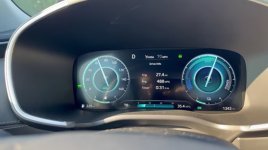tesla 1
Member
Plug-in Hybrid Electric Vehicles (PHEVs) have been touted as a "bridge" between traditional internal combustion engine vehicles (ICEs) and fully electric vehicles (EVs). They offer both a battery-powered electric drive and a conventional gasoline engine, which theoretically allows for the benefits of electric driving without the range anxiety that comes with pure EVs. However, PHEVs have been criticized for several reasons, leading some to argue that they may be a false promise for sustainability. Here are some of the key problems:
1. Limited Electric Range
Most PHEVs have a relatively small battery and therefore a limited electric-only range, often between 20 to 50 miles. While this might suffice for short commutes or errands, it doesn't cater to long-distance driving without relying on the gasoline engine. Many drivers end up using the gasoline engine more frequently, diminishing the environmental benefits.

2. Inconsistent Real-World Fuel Economy
Although PHEVs are marketed with impressive fuel economy figures, these numbers often don’t reflect real-world driving patterns. If the electric range is depleted and the vehicle switches to its gasoline engine, the fuel efficiency can drop dramatically, often close to or even worse than conventional ICE cars due to the added weight of the battery.
3. User Behavior
PHEVs require regular charging to maximize their environmental benefits, but many users don’t charge them as often as necessary. This is particularly problematic for fleet users or people who rely on the gasoline engine for long trips. In these cases, the PHEV essentially functions as a heavy, inefficient gasoline vehicle most of the time.
4. Emissions Regulations Loopholes
Some critics argue that PHEVs are used by automakers to meet emissions regulations without delivering substantial real-world emissions reductions. PHEVs can perform well in lab-based emissions tests because they start on electric power, leading to lower emissions during the testing process. However, in practice, if drivers don’t frequently charge their PHEVs, the emissions can be much higher than the tests suggest.
5. Environmental Impact of Battery and Engine
PHEVs have both an internal combustion engine and a battery, meaning they combine the manufacturing impacts of both technologies. The production of batteries is energy-intensive and has environmental consequences (e.g., mining for lithium, cobalt). At the same time, producing an ICE adds weight and complexity, meaning that PHEVs may not be as "green" as they seem once the full lifecycle environmental impact is considered.
6. Added Complexity
PHEVs are more complex than either ICE or full-electric vehicles, given that they house both powertrains. This complexity can lead to higher maintenance costs and a greater potential for mechanical problems. Additionally, the vehicles are often heavier, which reduces efficiency when running on gasoline.
7. High Costs
The dual powertrain adds cost to PHEVs. Despite incentives, they are often more expensive than comparable ICE vehicles. While government subsidies and incentives can offset some of these costs, not all buyers are eligible, and the long-term savings depend on individual driving patterns and charging habits.
8. Slow Progress Toward Full Electrification
PHEVs may slow the transition to full EVs by offering a "compromise" solution that delays adoption of fully electric vehicles. Critics argue that investing in and promoting PHEVs distracts from the need to build better charging infrastructure and develop better battery technologies for fully electric vehicles.
9. Unclear Role in a Decarbonized Future
While PHEVs might seem like a step in the right direction, their role in a future with net-zero carbon emissions is unclear. Fully electric vehicles, combined with renewable energy sources, are seen as the ideal for decarbonizing transportation. PHEVs may only serve as a short-term solution rather than a long-term one.
Conclusion: A False Promise?
While PHEVs offer a temporary solution for drivers who want the flexibility of electric driving without range anxiety, they often fall short of their potential due to inconsistent real-world performance and consumer behavior. For those committed to reducing their carbon footprint, fully electric vehicles may offer a more effective and sustainable option in the long run. The criticisms suggest that PHEVs might not be the most viable bridge to a green future, potentially representing a "false promise" in the shift toward sustainable transportation.
Youtube
1. Limited Electric Range
Most PHEVs have a relatively small battery and therefore a limited electric-only range, often between 20 to 50 miles. While this might suffice for short commutes or errands, it doesn't cater to long-distance driving without relying on the gasoline engine. Many drivers end up using the gasoline engine more frequently, diminishing the environmental benefits.

2. Inconsistent Real-World Fuel Economy
Although PHEVs are marketed with impressive fuel economy figures, these numbers often don’t reflect real-world driving patterns. If the electric range is depleted and the vehicle switches to its gasoline engine, the fuel efficiency can drop dramatically, often close to or even worse than conventional ICE cars due to the added weight of the battery.
3. User Behavior
PHEVs require regular charging to maximize their environmental benefits, but many users don’t charge them as often as necessary. This is particularly problematic for fleet users or people who rely on the gasoline engine for long trips. In these cases, the PHEV essentially functions as a heavy, inefficient gasoline vehicle most of the time.
4. Emissions Regulations Loopholes
Some critics argue that PHEVs are used by automakers to meet emissions regulations without delivering substantial real-world emissions reductions. PHEVs can perform well in lab-based emissions tests because they start on electric power, leading to lower emissions during the testing process. However, in practice, if drivers don’t frequently charge their PHEVs, the emissions can be much higher than the tests suggest.
5. Environmental Impact of Battery and Engine
PHEVs have both an internal combustion engine and a battery, meaning they combine the manufacturing impacts of both technologies. The production of batteries is energy-intensive and has environmental consequences (e.g., mining for lithium, cobalt). At the same time, producing an ICE adds weight and complexity, meaning that PHEVs may not be as "green" as they seem once the full lifecycle environmental impact is considered.
6. Added Complexity
PHEVs are more complex than either ICE or full-electric vehicles, given that they house both powertrains. This complexity can lead to higher maintenance costs and a greater potential for mechanical problems. Additionally, the vehicles are often heavier, which reduces efficiency when running on gasoline.
7. High Costs
The dual powertrain adds cost to PHEVs. Despite incentives, they are often more expensive than comparable ICE vehicles. While government subsidies and incentives can offset some of these costs, not all buyers are eligible, and the long-term savings depend on individual driving patterns and charging habits.
8. Slow Progress Toward Full Electrification
PHEVs may slow the transition to full EVs by offering a "compromise" solution that delays adoption of fully electric vehicles. Critics argue that investing in and promoting PHEVs distracts from the need to build better charging infrastructure and develop better battery technologies for fully electric vehicles.
9. Unclear Role in a Decarbonized Future
While PHEVs might seem like a step in the right direction, their role in a future with net-zero carbon emissions is unclear. Fully electric vehicles, combined with renewable energy sources, are seen as the ideal for decarbonizing transportation. PHEVs may only serve as a short-term solution rather than a long-term one.
Conclusion: A False Promise?
While PHEVs offer a temporary solution for drivers who want the flexibility of electric driving without range anxiety, they often fall short of their potential due to inconsistent real-world performance and consumer behavior. For those committed to reducing their carbon footprint, fully electric vehicles may offer a more effective and sustainable option in the long run. The criticisms suggest that PHEVs might not be the most viable bridge to a green future, potentially representing a "false promise" in the shift toward sustainable transportation.
Youtube
